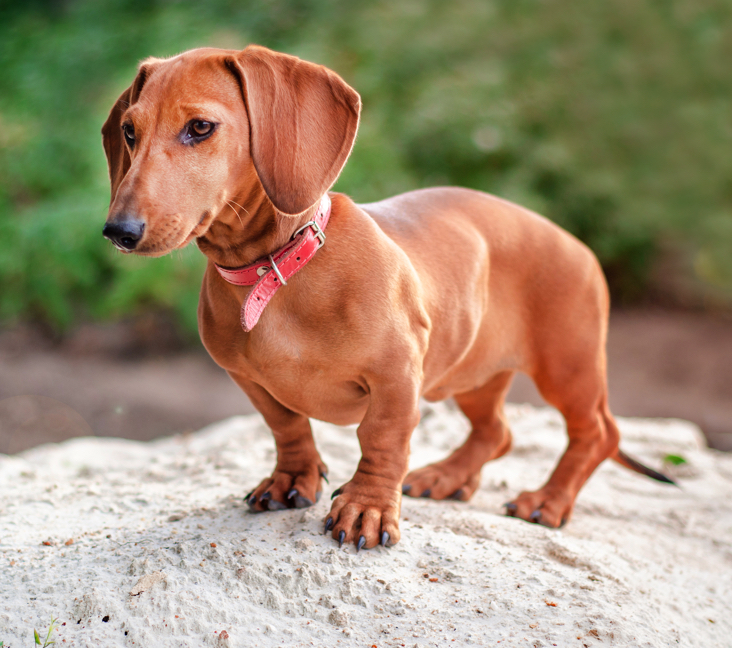Ever wondered when your adorable dachshund will stop growing? Understanding “when do dachshunds stop growing” can help you provide the best care possible. In this comprehensive guide, we’ll explore the typical timeline for dachshunds to reach their full size, the stages of their development, and the factors that influence their growth. By the end, you’ll know what to expect as your dachshund grows and how to support their healthy development.

When Do Dachshunds Stop Growing?
Typical Age Range for Reaching Full Growth
Most dachshunds reach their full size between 12 to 18 months. However, growth can vary based on several factors. While some may reach their adult size as early as 10 months, others might take up to 24 months. Knowing when dachshunds stop growing helps you understand and manage their nutritional and exercise needs better.

Variations in Growth Patterns
Just like humans, dachshunds have individual growth patterns. Some might experience rapid growth spurts, while others grow steadily over time. Monitoring your dog’s weight and size regularly can help you identify any unusual growth patterns early on, allowing you to address potential health issues promptly.
Dachshund Growth Stages
Puppyhood (0-6 Months)
Rapid Growth Phase
The first six months of a dachshund’s life are marked by rapid growth. During this time, they gain weight quickly and grow taller week by week. It’s crucial to provide a balanced diet rich in nutrients to support their development.
Weight and Size Expectations
At this stage, a standard dachshund puppy typically weighs between 4 to 11 pounds, while a miniature dachshund ranges from 2 to 5 pounds. Regularly tracking their weight ensures they’re growing at a healthy rate and helps you adjust their diet as needed.

Adolescence (6-12 Months)
Slower Growth
Between six to twelve months, your dachshund’s growth slows down. This stage is less about rapid physical changes and more about muscle and bone development. It’s important to continue providing a nutritious diet and moderate exercise.
Changes in Weight and Height
During adolescence, standard dachshunds usually weigh between 11 to 20 pounds. Miniature dachshunds, on the other hand, range from 5 to 11 pounds. While their growth isn’t as noticeable, they’re still developing internally and need consistent care.
Adulthood (12-18 Months)
Reaching Full Size
By the time they reach 12 to 18 months, most dachshunds have attained their full adult size. Their bones are fully developed, and they’ve reached their genetic height and weight potential. It’s a time to transition from puppy food to adult dog food to maintain their health.
Weight Stabilization
In adulthood, standard dachshunds typically weigh between 16 to 32 pounds, while miniatures weigh around 11 pounds or less. Monitoring their weight helps ensure they remain within a healthy range, preventing obesity and related health issues.

Weight Expectations by Age
Average Weight at Different Growth Stages
Understanding the average weight expectations at different growth stages helps ensure your dachshund is growing healthily. Here’s a detailed look at the weight milestones for both standard and miniature dachshunds:
| Age Range | Standard Dachshund Weight | Miniature Dachshund Weight |
| 0-6 months | 4-11 pounds | 2-5 pounds |
| 6-12 months | 11-20 pounds | 5-11 pounds |
| 12-18 months | 16-32 pounds | Less than 11 pounds |
These guidelines can help you monitor when dachshunds stop growing and ensure they maintain a healthy development. Specifically, knowing when do dachshunds stop growing will help tailor your care to their unique needs.
Comparison Between Standard and Miniature Dachshunds
Standard and miniature dachshunds exhibit distinct growth patterns and size expectations. Standard dachshunds typically grow larger and heavier, reaching weights between 16-32 pounds by 18 months. In contrast, miniature dachshunds are smaller, with adult weights usually under 11 pounds.
Understanding these differences is crucial for providing appropriate care and feeding. For instance, standard dachshunds may require more calories and exercise, while miniatures need a diet and activity level suitable for their smaller size. Knowing when do mini dachshunds stop growing-usually around 12 months-can help you adjust their diet and exercise to support healthy development. Tailoring your approach based on these growth patterns ensures that both standard and miniature dachshunds thrive.

Factors Influencing Growth
Genetics
Genetics play a significant role in determining when do dachshunds stop growing and how large they will eventually become. The size of the parents and the breed lines can greatly influence the growth potential of your dachshund. For example, if both parents are on the larger side, your dachshund is more likely to grow larger as well. Conversely, if they come from a line of smaller dachshunds, they may stay more petite. Understanding your dachshund’s genetic background can provide valuable insights into their expected growth patterns, helping you better anticipate when they will reach their full size and how to support their development effectively.
Diet and Nutrition
A balanced diet plays a crucial role in the healthy growth of your dachshund. It’s vital to provide a well-rounded mix of proteins, fats, carbohydrates, vitamins, and minerals through high-quality dog food specifically tailored to their life stage. Choosing the best dog food for dachshunds ensures they receive the essential nutrients for optimal growth and development.
Both overfeeding and malnutrition can negatively impact your dachshund’s growth. Overfeeding can lead to obesity, which puts additional strain on their long backs and joints, increasing the risk of intervertebral disc disease (IVDD). On the other hand, malnutrition can stunt their growth and weaken their immune system. Regularly monitoring your dog’s weight and adjusting their diet as needed is essential for their well-being. Consulting with your veterinarian for personalized dietary recommendations can further ensure your dachshund remains healthy and thrives at every stage of their life.
Exercise and Physical Activity
Regular exercise plays a vital role in developing muscle strength and maintaining overall health for dachshunds. Engaging in activities such as daily walks, playful sessions of fetch, and supervised playtime contributes significantly to their fitness and well-being. Aim for at least 30 minutes of exercise each day to keep your dachshund physically active and mentally stimulated.
It’s important to balance exercise with caution, especially because dachshunds are susceptible to back issues due to their elongated bodies. Avoiding activities that involve jumping or excessive running is crucial to prevent potential injuries and support their long-term mobility and health. By providing consistent and appropriate exercise, you can ensure your dachshund stays happy, healthy, and active throughout their life.

Health Conditions
Certain health conditions can affect your dachshund’s growth. Issues like hypothyroidism, parasites, and bone disorders can impede their development. Regular veterinary check-ups help identify and address these issues early.
Regular vet visits are essential for monitoring your dachshund’s growth and overall health. Your vet can provide guidance on diet, exercise, and any medical concerns, ensuring your dog grows up healthy and strong.
Signs That Your Dachshund Has Stopped Growing
Identifying when do dachshunds stop growing involves observing both physical indicators and behavioral changes:
Physical Indicators
- Adult Size and Weight: Your dachshund will reach their full adult size and weight, typically by around 18 months of age. This marks the end of their growth phase.
- Stable Growth Pattern: Once they reach adulthood, monitor their size and weight to ensure they maintain a stable growth pattern within a healthy range.

Physical Indicators
Behavioral Changes
- Decreased Playfulness: As dachshunds mature, they may exhibit less puppy-like behavior, showing decreased playfulness and more calmness.
- Adult Temperament: Their energy levels stabilize, and they settle into their adult temperament, indicating they have reached adulthood.
Understanding these signs helps you gauge when do dachshunds stop growing and ensure they transition smoothly into adulthood while maintaining their health and vitality.

Veterinary Advice
Importance of Monitoring Growth
Monitoring your dachshund’s growth helps ensure they develop healthily. Regular check-ups and weight tracking provide valuable insights into their development and help prevent potential health issues.
When to Consult a Vet for Growth Concerns
If you notice any irregularities in your dachshund’s growth, consult your vet. Issues like stunted growth, excessive weight gain, or unusual physical developments warrant professional advice to address them promptly.

FAQs
Can diet affect when dachshunds stop growing?
Yes, diet significantly influences when dachshunds reach their full growth potential. Providing a balanced diet tailored to their specific nutritional needs is essential for healthy development. A well-rounded diet, as outlined in a dachshund feeding chart, ensures they receive adequate nutrients crucial for bone and muscle growth. Conversely, poor nutrition or overfeeding can lead to issues such as stunted growth or obesity, impacting their overall health and potentially delaying their growth milestones. Monitoring their diet closely, based on their age, weight, and activity level, helps optimize their growth trajectory and supports their long-term health and vitality.
Do miniature dachshunds stop growing earlier than standard dachshunds?
Yes, miniature dachshunds tend to reach their full size earlier compared to standard dachshunds. Miniature dachshunds typically stop growing and reach their adult size by around 12 months of age. In contrast, standard dachshunds may continue to grow slightly longer, often reaching their full adult size between 12 to 18 months. Monitoring their growth closely during these stages is important to ensure they develop healthily and to address any potential health concerns promptly.
What are the signs of stunted growth in dachshunds?
Signs of stunted growth in dachshunds manifest as noticeable deviations from typical growth patterns for their age. These include being considerably smaller than expected, unusual weight fluctuations, and delayed physical development milestones such as teeth eruption or coat growth. It’s crucial to monitor these signs closely as they may indicate underlying health issues or nutritional deficiencies. Consulting your veterinarian promptly if you observe these signs is essential to ensure your dachshund receives appropriate care and intervention to support their healthy growth and development throughout their lifespan. Understanding these indicators plays a key role in assessing when dachshunds reach their full growth potential.
Conclusion
Understanding when do dachshunds stop growing and recognizing the stages of their development is crucial for providing comprehensive care. Genetic predispositions, alongside factors such as diet and exercise, significantly influence their growth trajectory. Regular monitoring and veterinary consultations are essential to ensure optimal health and development for your dachshund.
Have questions or want to share your dachshund’s growth story? Join the conversation in the comments below!

Cuddle Companions is your go-to resource for everything you need to keep your furry friends happy and healthy. We specialize in providing detailed and helpful information about the best foods, treats, and care practices for pets of all kinds. Whether you’re a seasoned pet owner or a new puppy parent, our team of experienced and passionate experts is dedicated to offering reliable advice and recommendations. At Cuddle Companions, we believe that a well-cared-for pet is a happy pet, and we’re here to help you every step of the way. Visit us at [bestdogfoodfordachshunds.net] for more information and resources.

